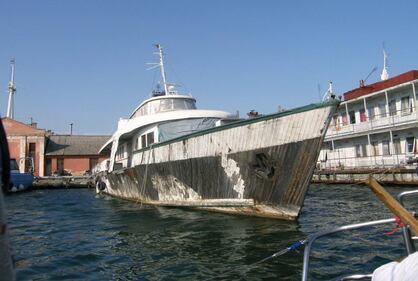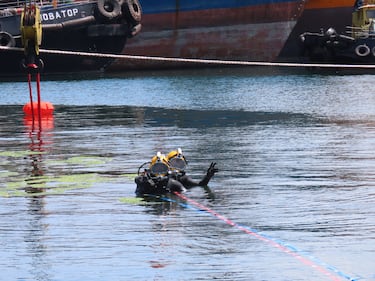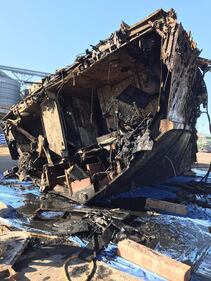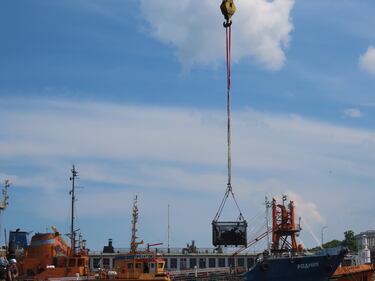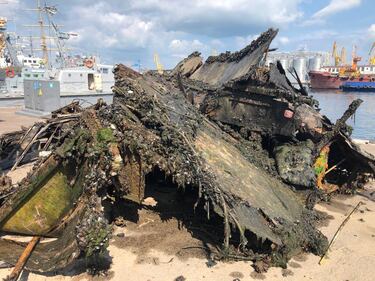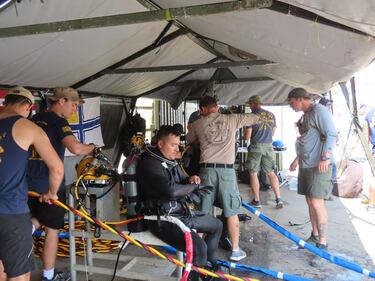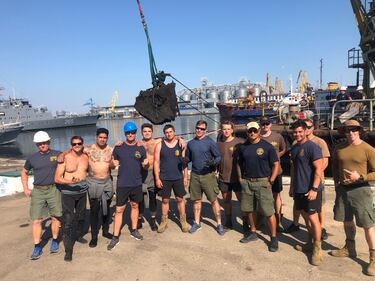ODESA, Ukraine — A port of vital interest to the U.S. military is bombed and destroyed in a future great-power battle, with sunken ships and piers in the water blocking access for ships trying to resupply American forces.
Navy Seabee divers and salvage divers are scattered across the theater conducting smaller missions, but the fight can’t continue until this major job is done — the underwater wreckage cleared and the port infrastructure rebuilt so resupply at this hub can resume. In this worst-case scenario for the U.S., the only way to get the port operating again may be to integrate the usually-separate divers — underwater construction and salvage — into a single unit unlike anything the Navy has fielded in the past.
That’s the scenario the Naval Expeditionary Combat Command has in mind as it prepares for future wars: it will almost certainly have to disaggregate the forces, but if the adversary hits a strategic hub, the command may not be able to wait until an entire salvage company or an entire underwater construction team can aggregate. The divers may need to be cross-trained, or at least familiar enough with each other’s missions and procedures to help out in a dire situation.
This focus on interoperability has driven two recent diving operations that integrated components of Underwater Construction Team 1 and Mobile Diving and Salvage Unit 2 into a “blended unit of action” that can take on complex underwater missions.
In Ukraine, as part of the Sea Breeze 21 international exercise, the team put its new integration to the test against a real problem: an old Soviet yacht abandoned at the Odesa naval base sank in 2016 and has since been blocking some half a dozen berthing spots the navy needs to support its growing fleet. After a couple years of planning, the U.S. Navy finally executed the mission to remove the yacht and free up the port — with UCT and MDSU divers working hand in hand.
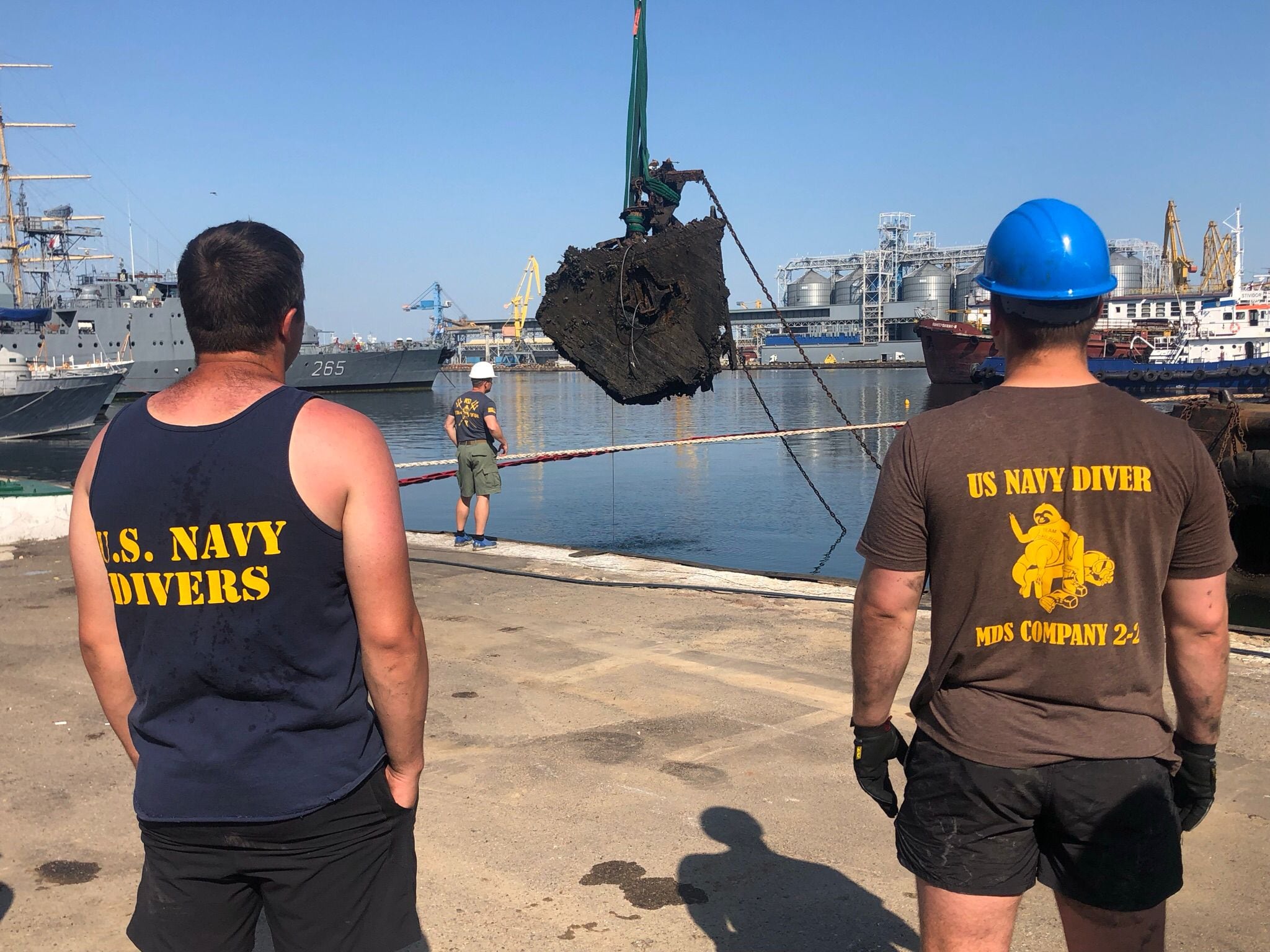
Just weeks later, the units came together again in their homeport of Virginia Beach to conduct a mission in the Large Scale Exercise 21 event that hews more closely to the worst-case scenario they could face in combat against a peer adversary.
The naval expeditionary combat forces were tasked with clearing and rebuilding a port — maybe an enemy port that was scuttled as U.S. forces approached, or maybe a port in an allied country that was hit by an enemy missile. Sunken ships or pieces of pier infrastructure are blocking access to the damaged port. In this high-end environment, MDSU divers broke apart and removed the items obstructing access; UCT assessed the port infrastructure and made underwater repairs; Seabees on land fixed piers and fendering above the water; explosive ordnance disposal units swept the area to ensure no unexploded weapons could hurt the sailors; and Maritime Expeditionary Security Forces teams ensured security at sea and ashore while the mission was ongoing.
“In some of the conflicts that we’re preparing for, we understand the maritime infrastructure is going to become a critical kind of tipping point: If we maintain and are able to facilitate the establishment of the appropriate amount of critical infrastructure, then we have the strategic advantage,” Cmdr. Steve Cobos, the commanding officer of Mobile Diving and Salvage Unit 2, told Defense News in a recent interview.
“If the enemy is able to deny that critical infrastructure from us, then they have the advantage,” he added. “As we look at concepts in order to create resiliency for the fleet commanders, the port damage repair is a concept that NECC has looked across and said, hey, we have these capabilities that are all across the spectrum. If we marry all these things together into one single unit of action, or one adaptive force package, then we can get at and solve some of those problems with respect to resiliency,”
The MDSU and UCT divers use the same dive equipment and the same health and safety standards for their dives and subsequent recompression efforts — but while underwater, they conduct vastly different missions, using different tools and requiring different training.
MDSU divers have some limited assessment skills, Cobos said, while UCT 1 Commanding Officer Lt. Cmdr. Seth McGuire said his divers have light salvage capabilities. Though they’ve been involved in common missions over the years, they’ve never really tried to integrate the way they are now.
Better integration between the diving units could help create additional capacity for the two small but in-demand communities and would help them more seamlessly conduct missions like port damage repair that require both their expertise.
Image 0 of 7
However, the driving motivation is that great power competition will likely ask naval expeditionary combat forces to operate in a more dispersed manner and, if a catastrophe occurs that divers have to respond to, it’s unclear what combination of units would be able to aggregate on the scene fastest. With time of the essence in a potential peer conflict, whatever blended unit can get on scene first has to be able to work together and get the mission done.
“NECC, our type commander, is really trying to find the right blend of capabilities to meet the needs of the changing Navy, and one of those things is disaggregating all of our operations and disaggregating our forces across the maritime environment and into the shore,” Cobos said.
“You may not have a full unit of action from either of those, either MDSU or UCT. But if we can get enough of the components of both of them to meet the mission requirements, then we can still execute and generate effects for the fleet. So the integration is really to provide some flexibility for decision-makers who have forces that are going to be distributed across an entire theater.”
Cobos and McGuire agree that the best way to improve integration is to first understand what each community brings, what their strengths and limitations are — and then to practice together often. That effort has started in earnest this summer.
Operations in Ukraine
Capt. Cameron Chen, the commodore of Task Force 68, which commands all naval expeditionary forces in Europe and Africa, called the yacht clearance event — done during Sea Breeze alongside divers from Ukraine, Georgia, Poland and Canada — the “highlight” of the exercise for his command.
“This yacht basically sank due to neglect. It was previously a part of the Ministry of Interior for the Soviet era, and it sat unattended for a number of years, and then in 2016 it started to sink,” he said during a Sea Breeze media teleconference. “We received a request from the Ukrainian government for some assistance in trying to remove this, so we’re finally able to do it during this exercise.”
Cobos said the Navy tried to include the salvage project in the 2019 iteration of Sea Breeze, but funding fell through. The COVID-19 pandemic forced the 2020 iteration to be an at-sea-only event.
Only this year was the Navy able to tackle the project.
Divers went into the water to survey the wreckage, which had deteriorated since previous surveys were done. They planned to use an underwater diamond wire saw to break the ship into four large pieces that could be lifted up out of the water with a crane, though at least one section was so badly deteriorated it fell apart during the crane lift, forcing divers to break off pieces by hand and put them into large baskets for removal.
Throughout the survey, cutting and removal processes, divers from MDSU 2 and UCT 1 worked side by side.
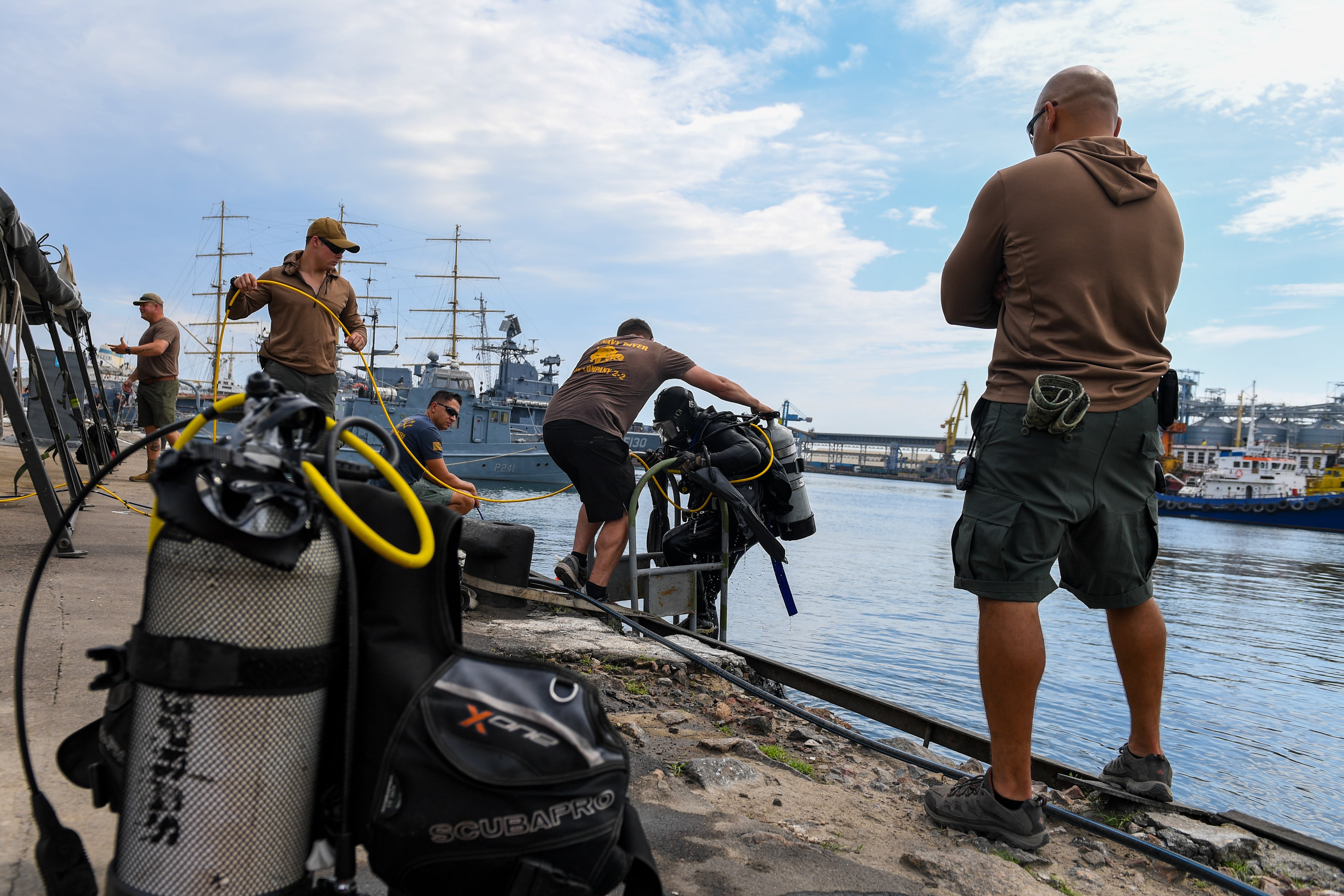
Chief Warrant Officer 2 Beau Lontine, the Company 2-2 commander in MDSU 2, told Defense News at the harbor in Odesa during Sea Breeze that MDSU 2 and UCT 1 each had a supervisor on watch any time personnel were in the water, and they were constantly talking at a tactical level about their differing procedures and which version made the most sense to follow for that part of the mission.
“They have a different methodology of how they do it. One, they have different methodology of how they brief their team, and then of course we all have our own idea of how things go, so they have different expectations of what will happen in the water,” Lontine said. “Perfect time for them to integrate, put their heads together as supervisors.”
He and his Seabee diver counterpart, as unit leaders on the scene, also worked closely on the planning side, discussing “what would you do and what would I do, and then we compare notes, and then we come up with daily objectives.”
“This job in particular, we’re teamed up with UCT 1 and then MDSU 2. Why? Because they’re in theater already, they have the same [equipment] loadout as we do in terms of gear — different expertise, right — but we overlap in that we’re both harbor clearance,” Lontine continued.
“UCT, they’re professionals at piers and quay walls and their ability to do hydrographic surveys; and then you have MDSU, who is the salvage experts,” he said. “This exercise, also leading into the next major exercise that we’ll be doing, we’re trying to bring UCT and deep sea together so that we can get all that expertise under one roof.”
Lontine said logistics contributed to the need for diver integration. MDSU 2 ran into some difficulties getting its gear into Ukraine, even though it was bringing a minimal amount. Instead, it had to rely on the forward-deployed detachment of UCT 1 and a stash of gear from the Supervisor of Salvage and Diving’s (SUPSALV) Emergency Ship Salvage Material (ESSM) inventory.
“We’re trying to utilize the salvage triad more effectively,” he said. “In other words, how do I leave Virginia and come out here and do a job and not have to use all my organic gear in Virginia, because logistically it’s a nightmare, it’s expensive, and now ESSM has stations throughout the world that I can pull from, they have an inventory.”
Cobos, who has been involved in planning this salvage mission for four years — first from the CTF 68 staff, then at NECC headquarters and now from MDSU 2 — said being cost-effective was a major factor in planning the mission and being able to argue for the funds.
“In order to get the salvage done on a shoestring budget within the constraints of the exercise, [the plan] was we’ll take the expertise and the personnel coming from [MDSU 2], we’ll fly them commercial with their personal dive equipment which they can bring, hand carry, then we’ll use a compilation of equipment coming from [the deployed detachment of UCT 1] and some salvage-specific stuff from the ESSM,” Cobos said.
Scaling up the integration
Large Scale Exercise 21 presented an even greater opportunity to rehearse a mission together. If the scenario in Ukraine was about cobbling together bits and pieces of personnel and gear from two diver communities that could quickly respond to a mission, LSE 21 rehearsed an all-hands-on-deck crisis that needed all components of the naval expeditionary combat force to bring to bear all their capabilities at once.
Navy and Marine Corps leaders have released few details about the LSE 21 scenario, other than to say “it’s a global scenario, it’s a worldwide scenario, and it builds up and then we end up in some sort of a crisis or in some sort of a fight.”
McGuire and Cobos didn’t identify the kind of item blocking access to the damaged port they were tasked with clearing and rebuilding. Instead, they said the most important aspect for them was working through building a command structure for the new adaptive force package and ensuring the various expeditionary units could work alongside each other safely and effectively.
McGuire said UCT 1 was in tactical control of the adaptive force package that included his divers, a MDSU 2 area search platoon and dive company, a Naval Mobile Construction Battalion detachment, an EOD mobile unit and a Maritime Expeditionary Security Forces squadron.
RELATED
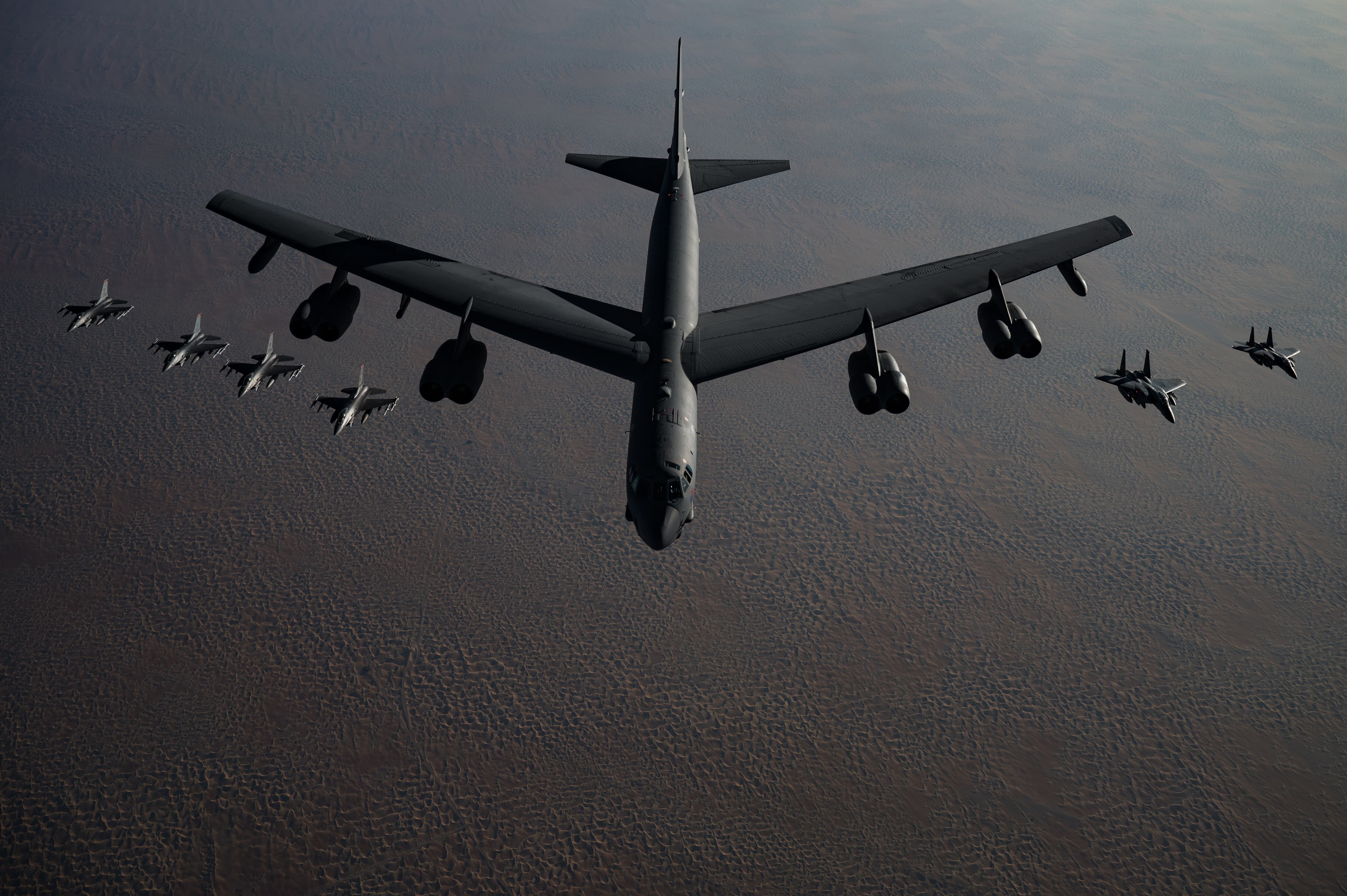
The scenario “forces all of those units to come together to bring that port back to usability,” McGuire said.
“It’s not often that we’re able to exercise all of the units in the same exercise, receiving centralized tasking and being forced to work together. So from the from the phasing of the operations to the communications, it very much is an example of what Navy Expeditionary Combat forces can accomplish.”
Cobos said the phasing piece was perhaps the most valuable piece to learn during LSE 21.
“One of the biggest things that we were looking at … was the orchestration of all the different capabilities that are going to be employed in a near-simultaneous kind of situation. For instance, if you’ve got an explosive hazard in the water column, how would that be mitigated with minimal impact to the other things that were occurring? Or if you had a waterborne attack, how would that affect our ability to do that all the other missions simultaneously?”
Cobos added that his MDSU divers needed to learn how the other units’ operations would affect their ability to conduct a salvage mission but also, conversely, how to help the other units “understand the limitations that our operations are placing upon the others, such that it’s really that synchronization, that layering of all those capabilities — and more specifically, the orchestration of who’s doing what, when, and how those interfere.”
Megan Eckstein is the naval warfare reporter at Defense News. She has covered military news since 2009, with a focus on U.S. Navy and Marine Corps operations, acquisition programs and budgets. She has reported from four geographic fleets and is happiest when she’s filing stories from a ship. Megan is a University of Maryland alumna.

